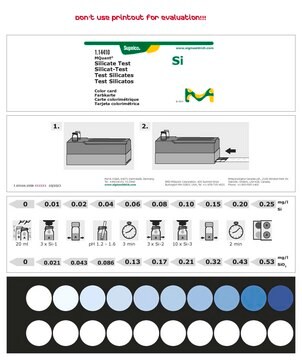1.19251
Oxygen Scavengers Test, photometric
photometric, 0.09-2.17 mg/L (MEKO), 0.08-1.95 mg/L (ISA), 0.05-1.32 mg/L (Hydro), 0.027-0.667 mg/L (Carbohy), 0.020-0.500 mg/L (DEHA), Spectroquant®
About This Item
Productos recomendados
product name
Oxygen Scavengers Test, photometric, 0.09-2.17 mg/L (MEKO), 0.08-1.95 mg/L (ISA), 0.05-1.32 mg/L (Hydro), 0.027-0.667 mg/L (Carbohy), 0.020-0.500 mg/L (DEHA), Spectroquant®
product line
Spectroquant®
Quality Level
usage
sufficient for 200 tests
analyte functional class(es)
oxygen scavengers
measuring range
0.020-0.500 mg/L (DEHA)
0.027-0.667 mg/L (Carbohy)
0.05-1.32 mg/L (Hydro)
0.08-1.95 mg/L (ISA)
0.09-2.17 mg/L (MEKO)
technique(s)
photometry: suitable
compatibility
for use with Spectroquant® Move 100
for use with Spectroquant® Nova 60 A
for use with Spectroquant® Prove 100
for use with Spectroquant® Prove 300
for use with Spectroquant® Prove 600
detection method
photometric (Iron reduction)
storage temp.
15-25°C
General description
This Spectroquant® Oxygen Scavengers Reagent Test allows the accurate quantification of the oxygen scavengers content in aqueous samples.
Method applied: In the presence of oxygen scavengers iron(III) ions are reduced to iron(II) ions. These react with a triazine derivative (FerroZine™) to form a violet complex which is determined photometrically.
The Spectroquant® Reagent Test Kits contain highly stable, ready-to-use reagent mixtures to perform the analysis according to the procedure described in the accompanying instruction leaflet.
All our Cell and Reagent Test Kits are equipped with the unique Live ID (2D barcode) which allows seamless method recognition and contains essential information such as lot number, expiry date, and automatic calibration updates.
Application
- Food Packaging and Shelf Life Extension: Oxygen scavengers are extensively used in food packaging to extend the shelf life of products by preventing oxidation. Recent research has demonstrated the application of oxygen scavengers in gel electromembrane extraction for the simultaneous determination of nitrate and nitrite in sausage samples. This green methodology enhances the accuracy of food quality assessments and ensures the safety of packaged foods (Samkumpim et al., Food Chemistry, 2023).
- Advanced Material Science: Oxygen scavengers are used in the development and characterization of advanced materials, including biodegradable films for active packaging. Recent research has explored the fabrication of ultraviolet light-driven green oxygen scavenging composites made of PVA/NRL for food packaging, providing an alternative to traditional metallic oxygen scavengers. This application demonstrates the potential for creating sustainable and efficient oxygen-scavenging materials (Ramakanth et al., Green Chemistry, 2024).
Analysis Note
Legal Information
signalword
Danger
hcodes
Hazard Classifications
Acute Tox. 4 Inhalation - Eye Dam. 1 - Met. Corr. 1 - Skin Corr. 1
supp_hazards
Storage Class
8B - Non-combustible, corrosive hazardous materials
wgk_germany
WGK 1
flash_point_f
Not applicable
flash_point_c
Not applicable
Certificados de análisis (COA)
Busque Certificados de análisis (COA) introduciendo el número de lote del producto. Los números de lote se encuentran en la etiqueta del producto después de las palabras «Lot» o «Batch»
¿Ya tiene este producto?
Encuentre la documentación para los productos que ha comprado recientemente en la Biblioteca de documentos.
Nuestro equipo de científicos tiene experiencia en todas las áreas de investigación: Ciencias de la vida, Ciencia de los materiales, Síntesis química, Cromatografía, Analítica y muchas otras.
Póngase en contacto con el Servicio técnico






